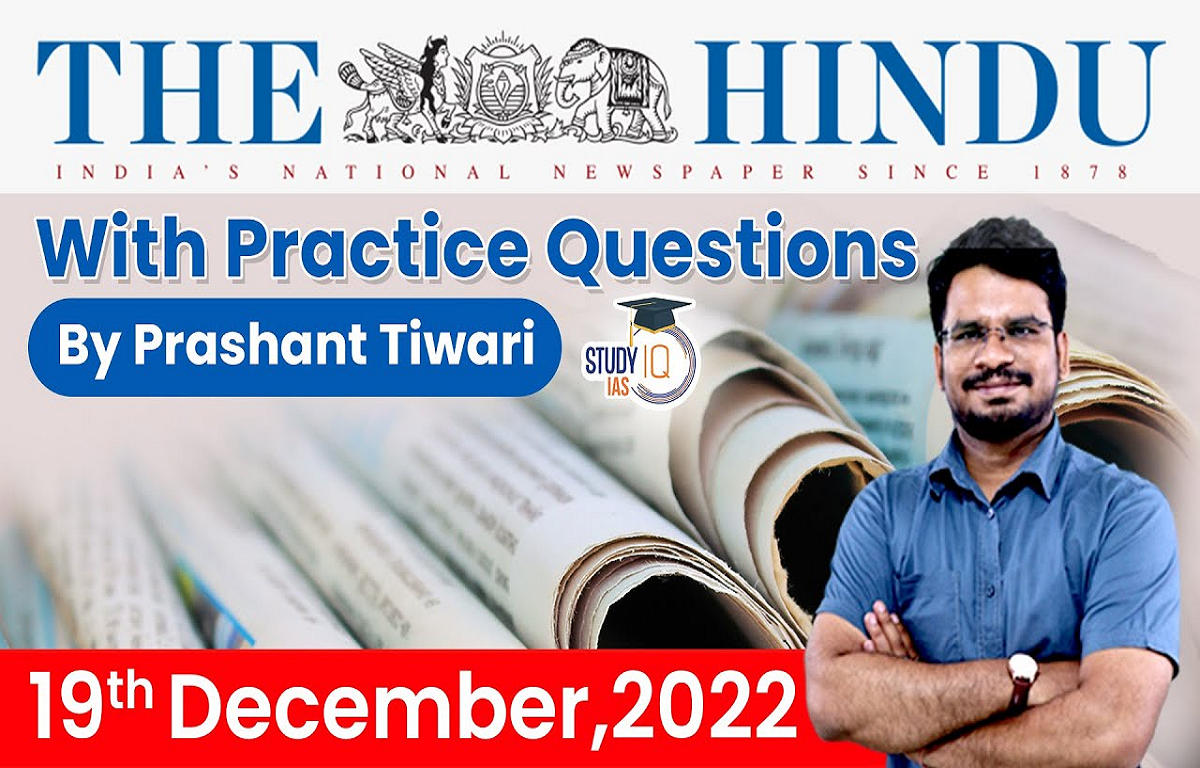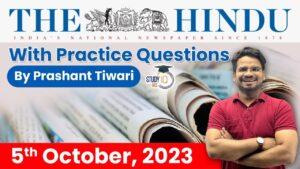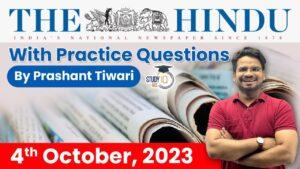The Hindu Newspaper Analysis for UPSC

The Hindu Newspaper Analysis 17 December 2022
- The Union government is all set to ease grant of citizenship to members of six minority communities from Pakistan, Afghanistan and Bangladesh whose passports and visas have ceased to be valid during their stay in India.
- The Home Ministry is expected to revamp the citizenship portal to accept passports and visas with expired validity as supporting documents to process citizenship application of Hindus, Sikhs, Parsis, Christians, Buddhists and Jains from the three countries, says a government source.
- The portal run by the Ministry currently accepts expired passports as supporting documents only for those Hindu and Sikh applicants from Pakistan and Afghanistan who entered India before December 31, 2009.
About CAA:
- The CAA provides citizenship on the basis of religion to six undocumented non-Muslim communities (Hindus, Sikhs, Buddhists, Jains, Parsis and Christians) from Pakistan, Afghanistan and Bangladesh who entered India on or before 31st December, 2014.
- It exempts the members of the six communities from any criminal case under the Foreigners Act, 1946 and the Passport Act, 1920.
- The two Acts specify punishment for entering the country illegally and staying here on expired visas and permits.

- Two important voices have weighed in recently on delays in the justice delivery system. The Chief Justice of India D.Y. Chandrachud stated that increasing the number of judges will not demolish the perennial problem of pendency, and that it is difficult enough now to find good High Court judge material.
- Sushil Kumar Modi, Chairman of Parliament’s Standing Committee on Law and Justice has called for out-of-the-box thinking to solve the problem.
- We have difficulty in finding good talent to be appointed as judges of the High Court, but year after year we see the spectacle of large numbers of experienced and fine judges retiring from the High Courts because they have reached the age of 62.
- Extend the out-of-box thinking and bring back retired Supreme Court judges to hear admission of Special Leave Petitions.
- But, the question arises, do we then not need more brick and mortar structures, office infrastructure and an army of staff? No, we do not, and that leads us to the second suggestion. Cultivate online justice.
- Lastly, employ mediation. As a method of dispute resolution, it is far superior to litigation in cases where it can be applied.
- Conventional reform prescribes more of the same — more judges, more courts, more staff, more infrastructure. But we know that we do not have the resources of either money or men and women. And, surely, we are tired of constant bewailing of the obvious and ever present problems.
- To recall Sri Aurobindo in his great writing The Hour of God, the moment has arrived; but will we lose it because the lamp has not been kept trimmed for the welcome and the ears are sealed to the call?

- One of the big achievements of Prime Minister Narendra Modi is that while administrative reforms are, usually, all about motherhood and apple pie proclamations such as “wash your hand before you eat”, he has turned at least some of it into action.
- First, the Modi government (thanks to the stellar work of economist Bibek Debroy) has repealed an estimated 2,000 Acts, statuettes and subordinate legislation which include dozens of Appropriation acts, the Excise Act 1863, Foreign Recruiting Act 1874, Elephants Preservation Act 1879, and Bengal Districts Act, 1836 to name just a few.
- Karnataka ranked 17th in the 2019 Business Reforms Action Plan (BRAP) national rankings, and this presents a significant opportunity for driving institutional reforms with respect to compliance.
- Third, another possible small step towards good governance is the DigiLocker (an integral part of the India stack) now has more than five billion documents and 100 million users. Likewise, the Union and State governments can set up enterprise DigiLockers to store all documents that any small or large business is expected to possess (Pan card, GSTN number, Aadhaar card, bank account details, etc.).
- Karnataka has implemented KUTUMBA (family beneficiary database), FRUITS (Farmer Registration and Unified beneficiary Information System), SVAMITVA (drone-based property and land mapping, or Survey of Villages Abadi and Mapping with Improvised Technology in Village Areas) and GraamaOne (single point assistance centre for citizen centric activities at panchayat level), all leading to more good governance.

- It is a matter of concern that the Supreme Court has declined to review its May 2022 order holding that the Gujarat government is the “appropriate government” to decide on the premature release of 11 convicts serving life terms in the Bilkis Bano gang-rape case, which also involved the gruesome murder of several others.
- A court’s jurisdiction to review its own order is limited to correcting any error apparent on the face of the record. It is also a discretionary remedy and generally not heard in open court.
What are the laws available on remissions?
- Under Articles 72 and 161 of the Constitution, the President and Governors have the power to pardon, and to suspend, remit, or commute a sentence passed by the courts.
- Since prisons is a state subject, state governments have powers under Section 432 of the CrPC to remit sentences.
- The remission policy of Gujarat, 1992 permitted prisoners to apply for remission on the basis that life imprisonment is an arbitrary or notional figure of twenty years of imprisonment.
- One of the convicts had approached the Gujarat High Court seeking remission of the sentence under sections 432 and 433 of the Code of Criminal Procedure.
- The high court dismissed his plea while observing that the “appropriate government” to take a decision about his remission is Maharashtra, and not Gujarat.
- He then filed a plea in the Supreme Court, pleading that he had been in jail for over 15 years without remission as of 1 April 2022.
- The apex court directed the Gujarat government to look into the issue of remission of his sentence following which the government formed a committee.
- The committee took a unanimous decision in favour of remission of all the 11 convicts in the case.

- Convened after a gap of six months, the Goods and Services Tax (GST) Council on Saturday cleared what officials called a ‘pathbreaking’ move to decriminalise certain offences by taxpayers, with a higher ₹2 crore threshold for initiating prosecutions, except in cases involving fake invoices.
- The Council took up a handful of other items — a 5% levy on husk of pulses used as a cattle feed input was scrapped, while the tax rate on items such as Fryums and Sports Utility Vehicles was ‘clarified’. These minutiae apart, the larger takeaway is the outcomes not pursued — including the tribunal proposal, virtually half the agenda was abandoned and discussions were curtailed to a little under three hours.
About:
- The GST Council is a joint forum of the Centre and the states.
- It was set up by the President as per Article 279A (1) of the amended Constitution.
- Members:
- The members of the Council include the Union Finance Minister (chairperson), the Union Minister of State (Finance) from the Centre.
- Each state can nominate a minister in-charge of finance or taxation or any other minister as a member.
Functions:
- The Council, according to Article 279, is meant to “make recommendations to the Union and the states on important issues related to GST, like the goods and services that may be subjected or exempted from GST, model GST Laws”.

- India ranks low in terms of visa-free/visa-on-arrival regimes for travellers in 2022.
- Indians can enjoy visa-free travel to 22 countries, according to Passport Index, an interactive and real-time ranking tool maintained by Arton Capital
- According to the index, India ranked a joint 69th in 2022 in terms of ease of mobility of travel to other countries.
- While India marginally improved in the index (its rank jumped four places from 73 in 2021), it still ranked below many Asian and developing countries. Countries such as South Africa (ranked 46), China (59), Brazil (11) and Russia (37) ranked higher, while India did better compared to other South Asian countries.
- The largely immigrant-populated UAE was ranked No. 1, followed by European and other developed countries. South Korea (joint 2nd) and Japan (4th) ranked the highest among Asian countries.
- A State-wise breakup (Chart 2) shows that Kerala had both the highest number (nearly 1.13 crore) and the highest proportion (an estimated 31.6% of the State’s population) of passport holders in the country.
- Among districts (Chart 3), Mumbai had the highest total number of passports issued (35,56,067) followed by Bengaluru (34,63,405), Malappuram (19,32,622), Chennai (18,85,855), Hyderabad (18,06,329), Ahmedabad (14,95,009) and Pune (14,52,236).

- In this era of globalisation, almost all nations are dependent on each other in the field of trade and hence rule-based freedom of navigation and security of sea lanes have become more important than ever for stability and economic progress of the world.
- commissioning ceremony of INS Mormugao, the second of four stealth guided missile destroyers being built under Project-15B.
- Named after the historic port city of Goa on the west coast, Mormugao, the ship was commissioned on the eve of the 60th anniversary of the liberation of Goa from Portuguese rule.
- These ships are equipped with BrahMos supersonic cruise missiles and long-range surface-to-air missiles.
- Some of the major indigenised equipment and systems aboard INS Mormugao include surface-to-surface and surface-to-air missiles, torpedo tubes and launchers, anti-submarine rocket launchers and super rapid gun mount, besides combat management system, integrated platform management system, automated power management system, foldable hangar doors, helo-traversing system, close-in weapon system, and bow-mounted SONAR, the Navy said.


- Prime Minister Narendra Modi on Sunday said the Union government had been investing heavily in Northeast India with his government’s motto being “Act fast for northeast and act first for northeast”.
- Addressing the golden jubilee celebration of the North Eastern Council (NEC) in Meghalaya’s capital, Shillong, he said the Centre was spending ₹7 lakh crore in the region now as against ₹2 lakh crore after India’s Independence.
- Established in 1971 and formally inaugurated in 1972, the NEC is the nodal agency for the economic and social development of the northeastern region comprising eight States.
About North Eastern Council (NEC)
- It is the nodal agency for the economic and social development of the North Eastern Region which consists of the eight States of Arunachal Pradesh, Assam, Manipur, Meghalaya, Mizoram, Nagaland, Sikkim and Tripura.
- It was constituted in 1971 by an Act of Parliament.
- NEC members: the Governors and the Chief Ministers of the 8 states including Sikkim, Chairman and 3 members who are nominated by the country’s President.
- The Union Cabinet, in June 2018, approved the proposal of Ministry of Development of North Eastern Region (DoNER) for the nomination of the Union Home Minister as ex-officio Chairman of North Eastern Council (NEC). The Cabinet also approved that Minister of State (Independent Charge), Ministry of DoNER would serve as Vice Chairman of the Council.

- Deep synthesis is defined as the use of technologies, including deep learning and augmented reality, to generate text, images, audio and video to create virtual scenes.
- Deepfakes are a compilation of artificial images and audio put together with machine-learning algorithms to spread misinformation and replace a real person’s appearance, voice, or both with similar artificial likenesses or voices. It can create people who do not exist and it can fake real people saying and doing things they did not say or do.
Q) With reference to the Zonal Councils, consider the following statements:
- The Zonal Councils are the Constitutional bodies.
- The Prime Minister is the Chairman of each of these Councils.
Which of the above statements is/are correct?
- 1 only
- 2 only
- Both 1 and 2
- Neither 1 nor 2
क्षेत्रीय परिषदों के संदर्भ में निम्नलिखित कथनों पर विचार कीजिये:
- क्षेत्रीय परिषदें संवैधानिक निकाय हैं।
- प्रधानमंत्री इनमें से प्रत्येक परिषद का अध्यक्ष होता है।
उपरोक्त कथनों में से कौन-सा/से सही है/हैं?
- केवल 1
- केवल 2
- 1 और 2 दोनों
- न तो 1 और न ही 2
Union Home Minister will attend the Eastern Zonal Council meeting in Kolkata on December 17, 2022.
- The idea of creation of Zonal Councils was mooted by the first Prime Minister of India, Pandit Jawahar Lal Nehru in 1956.
- The Zonal Councils are the statutory bodies.
- They are established by an Act of the Parliament, that is, States Reorganisation Act of 1956.
- The act divided the country into five zones (Northern, Central, Eastern, Western and Southern) and provided a zonal council for each zone.
- The present composition of each of these Zonal Councils is as under:
- The Northern Zonal Council, comprising the States of Haryana, Himachal Pradesh, Jammu & Kashmir, Punjab, Rajasthan, National Capital Territory of Delhi and Union Territory of Chandigarh;
- The Central Zonal Council, comprising the States of Chhattisgarh, Uttarakhand, Uttar Pradesh and Madhya Pradesh;
- The Eastern Zonal Council, comprising the States of Bihar, Jharkhand, Orissa and West Bengal;
- The Eastern Zonal Council, comprising the States of Bihar, Jharkhand, Orissa and West Bengal;
- The Western Zonal Council, comprising the States of Goa, Gujarat, Maharashtra and the Union Territories of Daman & Diu and Dadra & Nagar Haveli;
- The Southern Zonal Council, comprising the States of Andhra Pradesh, Karnataka, Kerala, Tamil Nadu and the Union Territory of Puducherry.
- North Eastern Council:
- The North Eastern States i.e. (i) Assam (ii) Arunachal Pradesh (iii) Manipur (iv) Tripura (v) Mizoram (vi) Meghalaya and (vii) Nagaland are not included in the Zonal Councils and their special problems are looked after by the North Eastern Council, set up under the North Eastern Council Act, 1972.
- The State of Sikkim has also been included in the North Eastern Council vide North Eastern Council (Amendment) Act, 2002 notified on 23rd December 2002.
What is the organisational structure of Zonal Councils?
- Chairman – The Union Home Minister is the Chairman of each of these Councils.
- Vice Chairman – The Chief Ministers of the States included in each zone act as Vice-Chairman of the Zonal Council for that zone by rotation, each holding office for a period of one year at a time.
Q) With reference to the E-20 Fuel, consider the following statements:
- The E20 fuel is a twenty percent blend of Ethanol and eighty percent of fossil based fuel.
- Flex engines are those that can run at any ratio of ethanol blending from E20 to E100.
Which of the above statements is/are correct?
- 1 only
- 2 only
- Both 1 and 2
- Neither 1 nor 2
E-20 ईंधन के संदर्भ में निम्नलिखित कथनों पर विचार कीजिये:
- E20 ईंधन इथेनॉल का बीस प्रतिशत और जीवाश्म आधारित ईंधन का अस्सी प्रतिशत मिश्रण है।
- फ्लेक्स इंजन वे होते हैं जो E20 से E100 तक इथेनॉल सम्मिश्रण के किसी भी अनुपात में चल सकते हैं।
उपरोक्त कथनों में से कौन-सा/से सही है/हैं?
- केवल 1
- केवल 2
- 1 और 2 दोनों
- न तो 1 और न ही 2
Union Petroleum and Natural Gas Minister has recently said that India will soon launch E-20 fuel with 20% blending of ethanol.
- The E20 fuel is a twenty percent blend of Ethanol and eighty percent of fossil based fuel.
- The introduction of E20 fuel has the motive of reducing the reliance on fossil based fuels for building a more sustainable society for the future and to reduce vehicular emissions.
- It is expected to reduce air pollution, being lesser polluting than petrol.
- The government foresees oil import savings to the tune of Rs. 30,000 crores annually.
What is Ethanol fuel?
- Ethanol fuel is ethyl alcohol, the same type of alcohol found in alcoholic drinks.
- It is most commonly utilized as a motor fuel, primarily as a biofuel addition in gasoline. Biomass is commonly utilized for making ethanol, such as corn or sugarcane. India’s abundance of sugarcane production is pivotal to the push towards ethanol based fuel.
Flex engines:
- Flex engines are those that can run at any ratio of ethanol blending from E20 to E100.
- These types of engines and cars are not new.
- The Fiat 147, launched in 1978 in Brazil, was the first production car to run solely on ethanol.
Q) With reference to the Wayanad Rice Festival, consider the following statements:
- The initiative aims to sensitise people to the significance of conserving traditional crops that have the ability to withstand harsh climatic conditions.
- Black rice varieties are rich in minerals like zinc, iron and other nutrients.
Which of the above statements is/are Incorrect?
- 1 only
- 2 only
- Both 1 and 2
- Neither 1 nor 2
वायनाड राइस फेस्टिवल के संदर्भ में निम्नलिखित कथनों पर विचार कीजिये:
- इस पहल का उद्देश्य लोगों को उन पारंपरिक फसलों के संरक्षण के महत्व के प्रति संवेदनशील बनाना है जो कठोर जलवायु परिस्थितियों का सामना करने की क्षमता रखती हैं।
- काले चावल की किस्में जिंक, आयरन और अन्य पोषक तत्वों जैसे खनिजों से भरपूर होती हैं।
उपरोक्त में से कौन सा/से कथन गलत है/हैं?
- केवल 1
- केवल 2
- 1 और 2 दोनों
- न तो 1 और न ही 2
A Kerala-based organisation named Thanal has embarked on a unique conservation experiment, planting 300 climate-resilient varieties of traditional rice on 1.5 acres of land at its agroecology centre in Panavally in the Wayanad district.
- The initiative aims to sensitise people to the significance of conserving traditional crops that have the ability to withstand harsh climatic conditions.
- Thanal has been organising annual “rice field weeks” since 2012.
- The festival also sets the stage for knowledge sharing and co-creation of knowledge between tribal farmers and experts.
- Thanal also launched the Rice Diversity Block (RDB) at Panavally under the Save Our Rice campaign in 2009, with a collection of 30 varieties of rice.
- Most of the varieties were collected from Kerala, Karnataka, Assam, Tamil Nadu, Arunachal Pradesh, Maharashtra and West Bengal.
- Many varieties are drought-resistant and flood-tolerant, while others have aromatic and medicinal properties.
- The Thondy variety, a traditional and popular rice among the people in Wayanad a few decades ago, could compete with any hybrid rice in terms of productivity.
- Black rice varieties are rich in minerals like zinc, iron and other nutrients.
- India had nearly 1.5 lakh varieties of rice, with about 3,000 varieties unique to Kerala.
Q) With reference to the Vacation Benches of the Supreme Court, consider the following statements:
- A vacation Bench of the Supreme Court is a special bench constituted by the Chief Justice of India.
- The Supreme Court takes two long vacations each year, the summer and winter breaks.
Which of the above statements is/are correct?
- 1 only
- 2 only
- Both 1 and 2
- Neither 1 nor 2
सर्वोच्च न्यायालय की अवकाश पीठों के संदर्भ में निम्नलिखित कथनों पर विचार कीजिएः
- सर्वोच्च न्यायालय की एक अवकाश पीठ भारत के मुख्य न्यायाधीश द्वारा गठित एक विशेष पीठ है।
- सुप्रीम कोर्ट हर साल दो लंबी छुट्टियां लेता है, गर्मी और सर्दी की छुट्टी।
उपरोक्त कथनों में से कौन-सा/से सही है/हैं?
- केवल 1
- केवल 2
- 1 और 2 दोनों
- न तो 1 और न ही 2
Chief Justice of India D. Y. Chandrachud recently said that no Vacation Benches will be available in the Supreme Court during the winter break.
- Who constitutes vacation bench?
- A Vacation Bench of the Supreme Court is a special bench constituted by the Chief Justice of India.
- When is vacation bench constituted?
- The Supreme Court takes two long vacations each year, the summer and winter breaks, but is technically not fully closed during these periods.
- Urgent matters:
- Litigants can still approach the Supreme Court during vacations and, if the court decides that the plea is an “urgent matter”, the Vacation Bench hears the case on its merits.
- While there is no specific definition as to what is an “urgent matter”, during vacations the court generally admits writs related to habeas corpus, certiorari, prohibition and quo warranto matters for enforcement of any fundamental right.
- Underlying rules:
- Under Rule 6 of Order II of The Supreme Court rules, 2013, the Chief Justice may appoint one or more Judges to hear during summer vacation or winter holidays all matters of an urgent nature.
Q) Exercise “SURYA KIRAN”, is between India and which of the following country?
- Nepal
- Bhutan
- Sri Lanka
- Indonesia
अभ्यास “सूर्य किरण”, भारत और निम्नलिखित में से किस देश के बीच है?
- नेपाल
- भूटान
- श्रीलंका
- इंडोनेशिया
Explanation :
The 16th Edition of exercise “SURYA KIRAN” will be conducted at Nepal Army Battle School, Saljhandi, and continue up to 29 December 2022.
- It is an Indo-Nepal joint army training exercise.
- It is conducted annually between India and Nepal with the aim to enhance inter-operability in jungle warfare and counter-terrorism operations in mountainous terrain and Humanitarian Assistance and Disaster Relief (HADR) under UN mandate.
- Nepal Army soldiers of Shree Bhawani Baksh Battalion and Indian Army soldiers from the 5 GR are participating in the exercise.
Mains Practice Question:
Q) “While the national political parties in India favour centralisation, the regional parties are in favour of State autonomy.” Comment. (150 words)
“जबकि भारत में राष्ट्रीय राजनीतिक दल केंद्रीकरण के पक्ष में हैं, क्षेत्रीय दल राज्य की स्वायत्तता के पक्ष में हैं।” टिप्पणी। (150 शब्द).


 The Hindu Newspaper Analysis 6 October 2...
The Hindu Newspaper Analysis 6 October 2...
 The Hindu Newspaper Analysis 5 October 2...
The Hindu Newspaper Analysis 5 October 2...
 The Hindu Newspaper Analysis 4 October 2...
The Hindu Newspaper Analysis 4 October 2...



















